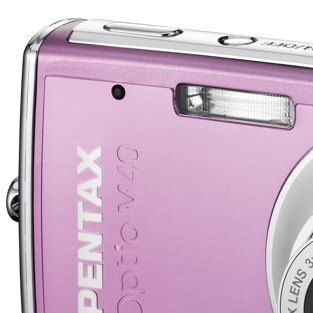The Pentax Optio M40 updates the Optio M30 with a few key tweaks that include a bump in pixels from seven to eight million pixels on a slightly larger sensor, a better resolution wide-view monitor and there’s improved flash output with a much improved shutter-lag response time.
Our quick take
The M40 is a nice camera, and that’s the problem, it is nice not brilliant. It looks nice, it handles nicely, and it’s nicely made.
It has a nice feature set, one that’s not the norm at this price point but does have that very odd lens problem.
In the end, I have to say the Pentax Optio M40 is marred by mediocrity in the image quality department something that in this competitive sector of the market is simply not good enough.

Pentax Optio M40 digital camera - 3.5 / 5
| FOR | AGAINST |
|---|---|
|
|
Add to this a minor lens focal length tweak from the M30’s 38-114mm 3x zoom to this models slightly wider-angle focal length of 36-108mm. In essence, the M40 is a 8-megapixel upgrade of a previously popular point and shoot, easy to use snapper and it enters a very competitive seven and eight million pixel compact market at a £140 SRP that looks good. But how well does the camera perform?
The 18mm thin body is very sleek indeed and its all-metal build is reassuring however, the battery and external storage (SD/SDHC cards) slot on the base is disappointingly plastic and feels fragile by comparison with the rest of the admittedly stylish camera.
An interesting design feature is the flared body design that actually makes the camera sit very nicely in the hand and in terms of handling, the camera is very easy to use, with a modicum of controls on the back plate next to the excellent colour screen. These controls include the lens zoom rocker, a four-way button array with central “OK” button, and a menu control. Finally, there’s a green button for quickly switching the camera back to its default, all-auto mode. The top plate houses a shutter releases and a small on/off button.
A set of 13 automated shooting modes include the usual array of night scene, and landscape settings along with a kids mode and natural skin tone setting that along with the portrait mode also fire up the face recognition focus and auto exposure mode. When a person is face on to the camera it works well enough but suffers if the person is not directly in front of the camera or is in profile for example.
The camera’s sensitivity range looks good too, running as it does from ISO 50 to 3200 but the down side is the camera’s signal to noise ratio means that noise is evident in images even at ISO 50. While it’s not intrusive at ISO 50, by the time you get to ISO 200 it is and beyond that point it becomes increasingly bad.
The camera’s auto mode will move the ISO up and down according to the subject and lighting but it is far to quick to push the sensitivity up, so manual control of this is key, particularly for enlargements of if you intend to crop an image for example.
The digital shake reduction is just another way of saying it uses a high sensitivity to provide a greater range of shutter speeds, it is not a “proper” anti shake mode and so all you get is images bursting with noise.
In terms of performance, there still a distinct lag between pressing the shutter button and getting a focus confirmation. However, the shutter lag is minimal once focus is achieved. Low light focusing is a problem as there’s no focus assist beam and I found the camera would just not be able to key on anything. Very frustrating indeed.
A couple of manual control options (despite the point and shoot ethos behind the camera) include full manual control of the ISO and exposure compensation to +/- 2EV and you can adjust the sharpness, saturation and contrast in each setting as well, all features not normally available on a camera at this level. So what of the all important image quality?
The good, better and best quality modes provide the usual array of compression settings and you can adjust the number of pixels you use from 8-megapixels to 640 x 480-pixels so plenty of flexibility here. Colour and sharpness are okay (plus those aforementioned adjustments mentioned above) by default. The metering is very good indeed with a mostly faultless performance.
The default sharpness is okay but on closer inspection images would benefit from some sharpening, also I found pixel fringing a problem at high contrast boundaries, which was bad on some images. But my biggest concern is reserved for the problems with the lens, which, at the periphery, is very soft indeed on some of my mid-zoom images.
It is so soft; it looks like the camera is applying a soft focus filter to the edges of some images. While the effect is not an unattractive one, it is just one that’s not supposed to be there … at all. Add barrel distortion to the mix that becomes is quite noticeable (but not unusual on such cameras) at wider focal lengths and that does not help the situation at all either.
To recap
The M40 is a nice camera, and that’s the problem, it is nice not brilliant
